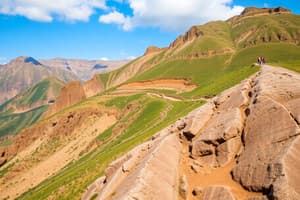Podcast
Questions and Answers
What is the primary focus of Physical Geography?
What is the primary focus of Physical Geography?
- The natural environment, including landforms, climate, and ecosystems (correct)
- Human populations and their social and cultural aspects
- Specific data or themes, such as climate, population, or economic activity
- The study and practice of making maps
What is the term for the study and practice of making maps?
What is the term for the study and practice of making maps?
- Cartology
- GIS (Geographic Information System)
- Cartography (correct)
- Topography
What is the purpose of Thematic Maps?
What is the purpose of Thematic Maps?
- To illustrate specific data or themes, such as climate, population, or economic activity (correct)
- To study and analyze geographically referenced data
- To display national and state boundaries, capitals, and major cities
- To show the relief and features of the Earth's surface
How many continents are there on Earth?
How many continents are there on Earth?
What is the purpose of GIS (Geographic Information System)?
What is the purpose of GIS (Geographic Information System)?
What do Latitude and Longitude measure?
What do Latitude and Longitude measure?
Flashcards are hidden until you start studying
Study Notes
Geography
Definition of Geography
- Study of the Earth's physical features, human populations, and the ways in which people interact with the environment.
Branches of Geography
- Physical Geography: focuses on the natural environment, including landforms, climate, and ecosystems.
- Human Geography: examines the social, cultural, and economic aspects of human populations and their interactions with the environment.
Key Concepts in Geography
- Latitude: measures distance north or south of the equator, ranging from 0° to 90°.
- Longitude: measures distance east or west of the prime meridian, ranging from 0° to 180°.
- Cartography: the study and practice of making maps.
- GIS (Geographic Information System): a computer-based tool for capturing, storing, and analyzing geographically referenced data.
Types of Maps
- Topographic Maps: show the relief and features of the Earth's surface.
- Political Maps: display national and state boundaries, capitals, and major cities.
- Thematic Maps: illustrate specific data or themes, such as climate, population, or economic activity.
Earth's Features
- Continents: 7 large landmasses, including Africa, Antarctica, Asia, Australia, Europe, North America, and South America.
- Oceans: 5 large bodies of saltwater, including the Pacific, Atlantic, Indian, Arctic, and Southern Oceans.
- Mountains: major ranges include the Himalayas, Andes, Rocky Mountains, and Alps.
- Rivers: longest rivers include the Nile, Amazon, Yangtze, and Mississippi.
Geography
Definition and Branches
- Geography is the study of the Earth's physical features, human populations, and the ways in which people interact with the environment.
- Divided into two main branches: Physical Geography and Human Geography.
Physical Geography
- Focuses on the natural environment, including landforms, climate, and ecosystems.
Human Geography
- Examines the social, cultural, and economic aspects of human populations and their interactions with the environment.
Key Concepts
Location and Mapping
- Latitude measures distance north or south of the equator, ranging from 0° to 90°.
- Longitude measures distance east or west of the prime meridian, ranging from 0° to 180°.
- Cartography is the study and practice of making maps.
- GIS (Geographic Information System) is a computer-based tool for capturing, storing, and analyzing geographically referenced data.
Types of Maps
- Topographic Maps: show the relief and features of the Earth's surface.
- Political Maps: display national and state boundaries, capitals, and major cities.
- Thematic Maps: illustrate specific data or themes, such as climate, population, or economic activity.
Earth's Features
- Continents: 7 large landmasses, including Africa, Antarctica, Asia, Australia, Europe, North America, and South America.
- Oceans: 5 large bodies of saltwater, including the Pacific, Atlantic, Indian, Arctic, and Southern Oceans.
- Mountains: major ranges include the Himalayas, Andes, Rocky Mountains, and Alps.
- Rivers: longest rivers include the Nile, Amazon, Yangtze, and Mississippi.
Studying That Suits You
Use AI to generate personalized quizzes and flashcards to suit your learning preferences.




